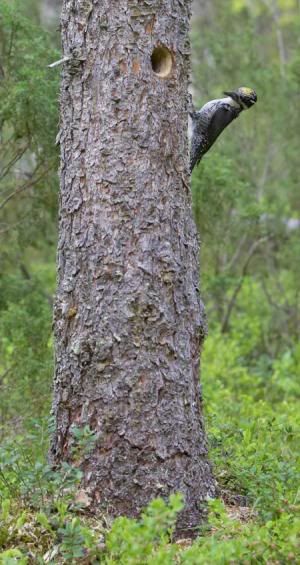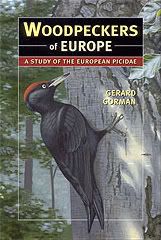 The ability that woodpeckers have of being able to excavate holes in trees is arguably the one thing that sets them apart from other birds. In Europe woodpeckers are primary hole-excavators, that is, they are the bird family that contributes most to the process of cavity making in forests. The fact that woodpeckers can excavate their own nesting and roosting cavities is one of the main reasons why they are successful. There are many advantages for both parents and chicks in being able to raise and be raised in the weatherproof haven of a chamber inside a tree. Being able to roost in such shelters is obviously an advantage for adults, too. There are three basic types of tree holes made by woodpeckers: nest holes, roost holes, feeding holes. Holes are arguably the most recognisable sign of woodpecker presence. There can be a significant turn over of nest holes in an area each year. Some are lost, as trees are felled or storm damaged, and new ones created. Old holes become unsuitable due to wear and tear, filling with water (from melting snow or rain), become infested with parasites, clogged with fungi or are usurped by other birds, mammals or wasp, hornets and bees. Some woodlands (for birds and birders high quality woodlands, for foresters low quality woodlands) are riddled with woodpecker holes. Favoured trees may contain several holes, made by one species or by several. As a rule, all woodpeckers will nest as high up in a tree as practical. Tree height and the height of the nest-hole entrance, both increase with increasing woodpecker body size. Though all kinds of factors (location, tree species, availability of suitable trees, forestry practises, predation risk) influence hole entrance height, in general Great Spotted, White-backed, Black and Green Woodpeckers will nest highest up in trees. Wryneck, Middle Spotted, Syrian and Grey-headed Woodpeckers will nest at medium heights, and Lesser Spotted and Three-toed Woodpecker nests will be the lowest. Of course, there will always be exceptions. Holes used for roosting rarely differ from nest-holes. This is because they are in fact often old nest-holes. Some woodpeckers excavate specific roost holes if there is a lack of cavities in an area. From the outside these will appear like nest-holes, though on the inside they may be less precise as those which are intended to house a brood of chicks. Notes on feeding-holes are mentioned in other posts in this blog. I will also post more on specific, species related, nest holes in this blog as I obtain the relevant photos. The photo here shows an adult male Three-toed Woodpecker at at nesthole site in Finland (Jari Peltomaki). The hole is around one metre above ground level. Such a height is not unusual for this species though most (but not all) other woodpecker species prefer to nest at a higher level.
The ability that woodpeckers have of being able to excavate holes in trees is arguably the one thing that sets them apart from other birds. In Europe woodpeckers are primary hole-excavators, that is, they are the bird family that contributes most to the process of cavity making in forests. The fact that woodpeckers can excavate their own nesting and roosting cavities is one of the main reasons why they are successful. There are many advantages for both parents and chicks in being able to raise and be raised in the weatherproof haven of a chamber inside a tree. Being able to roost in such shelters is obviously an advantage for adults, too. There are three basic types of tree holes made by woodpeckers: nest holes, roost holes, feeding holes. Holes are arguably the most recognisable sign of woodpecker presence. There can be a significant turn over of nest holes in an area each year. Some are lost, as trees are felled or storm damaged, and new ones created. Old holes become unsuitable due to wear and tear, filling with water (from melting snow or rain), become infested with parasites, clogged with fungi or are usurped by other birds, mammals or wasp, hornets and bees. Some woodlands (for birds and birders high quality woodlands, for foresters low quality woodlands) are riddled with woodpecker holes. Favoured trees may contain several holes, made by one species or by several. As a rule, all woodpeckers will nest as high up in a tree as practical. Tree height and the height of the nest-hole entrance, both increase with increasing woodpecker body size. Though all kinds of factors (location, tree species, availability of suitable trees, forestry practises, predation risk) influence hole entrance height, in general Great Spotted, White-backed, Black and Green Woodpeckers will nest highest up in trees. Wryneck, Middle Spotted, Syrian and Grey-headed Woodpeckers will nest at medium heights, and Lesser Spotted and Three-toed Woodpecker nests will be the lowest. Of course, there will always be exceptions. Holes used for roosting rarely differ from nest-holes. This is because they are in fact often old nest-holes. Some woodpeckers excavate specific roost holes if there is a lack of cavities in an area. From the outside these will appear like nest-holes, though on the inside they may be less precise as those which are intended to house a brood of chicks. Notes on feeding-holes are mentioned in other posts in this blog. I will also post more on specific, species related, nest holes in this blog as I obtain the relevant photos. The photo here shows an adult male Three-toed Woodpecker at at nesthole site in Finland (Jari Peltomaki). The hole is around one metre above ground level. Such a height is not unusual for this species though most (but not all) other woodpecker species prefer to nest at a higher level.
Thursday, 13 September 2007
Woodpecker signs: holes
 The ability that woodpeckers have of being able to excavate holes in trees is arguably the one thing that sets them apart from other birds. In Europe woodpeckers are primary hole-excavators, that is, they are the bird family that contributes most to the process of cavity making in forests. The fact that woodpeckers can excavate their own nesting and roosting cavities is one of the main reasons why they are successful. There are many advantages for both parents and chicks in being able to raise and be raised in the weatherproof haven of a chamber inside a tree. Being able to roost in such shelters is obviously an advantage for adults, too. There are three basic types of tree holes made by woodpeckers: nest holes, roost holes, feeding holes. Holes are arguably the most recognisable sign of woodpecker presence. There can be a significant turn over of nest holes in an area each year. Some are lost, as trees are felled or storm damaged, and new ones created. Old holes become unsuitable due to wear and tear, filling with water (from melting snow or rain), become infested with parasites, clogged with fungi or are usurped by other birds, mammals or wasp, hornets and bees. Some woodlands (for birds and birders high quality woodlands, for foresters low quality woodlands) are riddled with woodpecker holes. Favoured trees may contain several holes, made by one species or by several. As a rule, all woodpeckers will nest as high up in a tree as practical. Tree height and the height of the nest-hole entrance, both increase with increasing woodpecker body size. Though all kinds of factors (location, tree species, availability of suitable trees, forestry practises, predation risk) influence hole entrance height, in general Great Spotted, White-backed, Black and Green Woodpeckers will nest highest up in trees. Wryneck, Middle Spotted, Syrian and Grey-headed Woodpeckers will nest at medium heights, and Lesser Spotted and Three-toed Woodpecker nests will be the lowest. Of course, there will always be exceptions. Holes used for roosting rarely differ from nest-holes. This is because they are in fact often old nest-holes. Some woodpeckers excavate specific roost holes if there is a lack of cavities in an area. From the outside these will appear like nest-holes, though on the inside they may be less precise as those which are intended to house a brood of chicks. Notes on feeding-holes are mentioned in other posts in this blog. I will also post more on specific, species related, nest holes in this blog as I obtain the relevant photos. The photo here shows an adult male Three-toed Woodpecker at at nesthole site in Finland (Jari Peltomaki). The hole is around one metre above ground level. Such a height is not unusual for this species though most (but not all) other woodpecker species prefer to nest at a higher level.
The ability that woodpeckers have of being able to excavate holes in trees is arguably the one thing that sets them apart from other birds. In Europe woodpeckers are primary hole-excavators, that is, they are the bird family that contributes most to the process of cavity making in forests. The fact that woodpeckers can excavate their own nesting and roosting cavities is one of the main reasons why they are successful. There are many advantages for both parents and chicks in being able to raise and be raised in the weatherproof haven of a chamber inside a tree. Being able to roost in such shelters is obviously an advantage for adults, too. There are three basic types of tree holes made by woodpeckers: nest holes, roost holes, feeding holes. Holes are arguably the most recognisable sign of woodpecker presence. There can be a significant turn over of nest holes in an area each year. Some are lost, as trees are felled or storm damaged, and new ones created. Old holes become unsuitable due to wear and tear, filling with water (from melting snow or rain), become infested with parasites, clogged with fungi or are usurped by other birds, mammals or wasp, hornets and bees. Some woodlands (for birds and birders high quality woodlands, for foresters low quality woodlands) are riddled with woodpecker holes. Favoured trees may contain several holes, made by one species or by several. As a rule, all woodpeckers will nest as high up in a tree as practical. Tree height and the height of the nest-hole entrance, both increase with increasing woodpecker body size. Though all kinds of factors (location, tree species, availability of suitable trees, forestry practises, predation risk) influence hole entrance height, in general Great Spotted, White-backed, Black and Green Woodpeckers will nest highest up in trees. Wryneck, Middle Spotted, Syrian and Grey-headed Woodpeckers will nest at medium heights, and Lesser Spotted and Three-toed Woodpecker nests will be the lowest. Of course, there will always be exceptions. Holes used for roosting rarely differ from nest-holes. This is because they are in fact often old nest-holes. Some woodpeckers excavate specific roost holes if there is a lack of cavities in an area. From the outside these will appear like nest-holes, though on the inside they may be less precise as those which are intended to house a brood of chicks. Notes on feeding-holes are mentioned in other posts in this blog. I will also post more on specific, species related, nest holes in this blog as I obtain the relevant photos. The photo here shows an adult male Three-toed Woodpecker at at nesthole site in Finland (Jari Peltomaki). The hole is around one metre above ground level. Such a height is not unusual for this species though most (but not all) other woodpecker species prefer to nest at a higher level.
Subscribe to:
Post Comments (Atom)





No comments:
Post a Comment